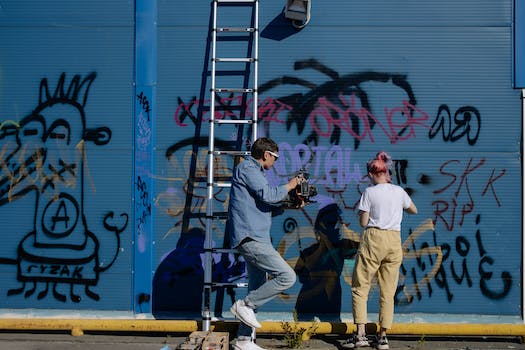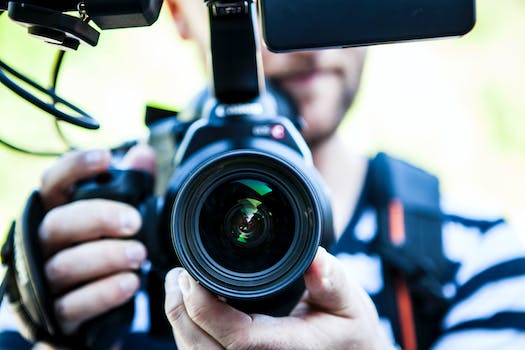Documentary and reality TV are two popular genres in the world of television. While they may seem similar at first glance, there are distinct differences between the two. Documentaries are non-fictional, informative programs that aim to educate and provide a deeper understanding of real-life subjects. On the other hand, reality TV is a genre that showcases unscripted situations and often focuses on entertaining aspects of everyday life. Understanding the disparities between these genres can help viewers choose the type of content that aligns with their preferences and interests.
- 1. Introduction
- 1.1. Definition of documentary
- 1.2. Definition of reality TV
- 1.3. Popularity of both genres
- 1.4. Purpose of the article
- 2. Narrative Structure
- 2.1. Storytelling in documentaries
- 2.2. Storytelling in reality TV
- 2.3. Use of scripts in reality TV
- 2.4. Documentary’s focus on facts
- 2.5. Reality TV’s focus on entertainment
- 3. Production Methods
1. Introduction
Documentary and reality TV are two popular genres of television programming that often confuse viewers due to their similarities. While both types of shows present events that are happening in real life, there are significant differences between them in terms of purpose, production, and storytelling. This article aims to explore and clarify those differences, providing a comprehensive understanding of documentary and reality TV as distinct forms of entertainment.
1.1. Definition of documentary
A documentary is a type of film or television program that aims to provide an informative and factual representation of real-life events, people, or social issues. It is a non-fictional genre of media production that often utilizes interviews, archival footage, and observational techniques to present a realistic portrayal of the subject matter. Documentaries can cover a wide range of topics such as history, science, politics, nature, and human interest stories. The primary goal of a documentary is to educate and enlighten the audience by presenting them with an unbiased and objective account of the subject being explored.
1.2. Definition of reality TV
Reality TV is a genre of television programming that showcases unscripted situations, real-life events, and ordinary people as the main subjects. It is distinct from documentary TV, which aims to present factual information and often follows a specific topic or story. Reality TV, on the other hand, focuses on capturing the drama, conflicts, emotions, and relationships of the participants in a highly entertaining manner. The term ‘reality TV’ was coined in the 1990s, and since then, it has become immensely popular, attracting a wide audience and spawning numerous subgenres like competition shows, dating shows, and celebrity-centered programs. This article aims to explore the differences between documentary and reality TV, highlighting their unique characteristics and purposes.
1.3. Popularity of both genres
Both documentary and reality TV have gained immense popularity in recent years. These genres offer a unique and captivating form of entertainment, providing viewers with a glimpse into real-life situations and experiences.
Documentaries have always been a preferred choice for those seeking a deeper understanding of various subjects. They are often based on real events, people, or social issues, presenting facts and information in a compelling and informative manner. Documentaries cover a wide range of topics, including history, science, nature, and human stories.
On the other hand, reality TV has exploded in popularity with the rise of shows like Survivor, The Bachelor, and Keeping Up with the Kardashians. This genre focuses on unscripted scenarios and the lives of real people, often showcasing their personal relationships, challenges, and conflicts. Reality TV offers a voyeuristic experience for viewers, allowing them to feel connected to the participants and their daily lives.
Both documentary and reality TV have their own unique appeal and offer different viewing experiences. While documentaries provide a more educational and informative approach, reality TV offers a more entertaining and dramatic experience. The popularity of both genres continues to grow as they cater to different audience preferences and interests.
1.4. Purpose of the article
The purpose of this article is to explore and highlight the key differences between documentary and reality TV. While both genres fall under the umbrella of non-fiction programming, they have distinct approaches and objectives. By understanding these differences, viewers can gain a deeper appreciation for the nuances of each genre and make more informed viewing choices.
2. Narrative Structure
Narrative structure plays a crucial role in distinguishing between documentary films and reality TV shows. While both forms of media aim to portray real-life events, they utilize different storytelling techniques to achieve their objectives.
In documentary films, the narrative structure is often more structured and organized. Filmmakers carefully plan the story they want to tell and present it in a cohesive and logical manner. They typically conduct extensive research, gather interviews and footage, and then arrange the material in a way that effectively communicates their intended message. The narrative in a documentary follows a chronological or thematic order, providing a clear and coherent exploration of the chosen subject.
On the other hand, reality TV shows tend to have a looser narrative structure. These shows often rely on unscripted and spontaneous situations, creating a sense of realism and unpredictability. The narrative in reality TV is often driven by the interactions and conflicts between the cast members, rather than a predetermined storyline. The editing process plays a significant role in shaping the narrative, as editors select and arrange footage to create engaging and dramatic moments.
Furthermore, documentary films strive to present an objective view of reality, focusing on facts and information. The narrative aims to educate and inform the audience, shedding light on important issues or providing insight into a specific topic. Reality TV, on the other hand, often prioritizes entertainment value over factual accuracy. The narrative is designed to engage viewers and keep them hooked, often incorporating elements of drama, competition, and personal relationships.
In summary, the narrative structure in documentary films is more structured and organized, aiming to inform and educate viewers. Reality TV shows, on the other hand, have a looser narrative structure that emphasizes entertainment and often relies on unscripted situations. Understanding the differences in narrative approach helps distinguish between these two forms of media.
2.1. Storytelling in documentaries
Storytelling in documentaries plays a crucial role in engaging viewers and conveying a compelling narrative. Unlike reality TV, which aims to entertain through dramatic situations and conflicts, documentaries focus on presenting real-life stories and information in a creative and informative way.
Narrative structure is an essential element of storytelling in documentaries. It provides a framework for organizing the content, creating a coherent flow, and capturing the audience’s attention. Documentaries often follow a three-act structure, similar to fictional narratives, consisting of an introduction, development, and resolution.
In the introduction phase, the documentary sets the stage by introducing the main subject or theme. It establishes the context, presents the key characters or issues, and hooks the viewers with an intriguing setup. This phase aims to engage the audience from the beginning and create anticipation for what is to come.
The development phase delves deeper into the subject matter, presenting various perspectives, interviews, and evidence to support the documentary’s central theme. It unfolds the story or topic in a logical and compelling manner, often using visual aids, archival footage, and expert analysis to enhance the narrative. This phase aims to provide a comprehensive exploration of the subject while maintaining the audience’s interest.
Finally, the resolution phase brings the documentary to a conclusion, wrapping up the main points, and leaving the viewers with a sense of closure. It may offer a resolution to conflicts or dilemmas presented earlier, provide a call to action, or simply leave the audience with something to ponder. The resolution phase aims to leave a lasting impact on the viewers and reinforce the documentary’s message.
Overall, storytelling in documentaries utilizes narrative structure to captivate audiences and present real-life stories in a compelling manner. By following a well-organized three-act structure, documentaries can effectively engage viewers and leave a lasting impression.
2.2. Storytelling in reality TV
Storytelling plays a vital role in the world of reality TV. It is the narrative structure that keeps viewers engaged and invested in the lives of the participants. Unlike documentaries, which aim to capture real-life events as they happen, reality TV uses storytelling techniques to shape the narrative and create a compelling viewing experience.
In reality TV, the narrative structure is carefully crafted to create drama, conflict, and emotional moments. Producers and editors work behind the scenes to piece together footage, interviews, and confessionals to create a cohesive storyline. This storytelling approach helps to create compelling characters and story arcs that keep viewers hooked.
One of the key elements of storytelling in reality TV is the use of character development. Participants are carefully selected to bring different personalities, backgrounds, and conflicts into the mix. As the season progresses, viewers get to witness the growth and transformation of these characters, creating a sense of attachment and investment.
Another storytelling technique commonly used in reality TV is the use of challenges and competitions. These events not only add excitement and entertainment value but also serve as plot devices to drive the narrative forward. They create moments of triumph, defeat, and unexpected twists, further engaging viewers in the story.
Furthermore, reality TV often employs the use of confessionals or one-on-one interviews with participants. These intimate moments allow viewers to get inside the minds of the characters, understand their motivations, and gain insight into their thoughts and emotions. Confessionals provide a direct way for participants to narrate their own stories, adding depth and perspective to the overall narrative.
In conclusion, storytelling is a fundamental aspect of reality TV. It helps to shape the narrative, create compelling characters, and engage viewers in the lives of the participants. By using techniques such as character development, challenges, and confessionals, reality TV creates a captivating viewing experience that keeps audiences coming back for more.
2.3. Use of scripts in reality TV
Reality TV shows often employ the use of scripts to enhance the narrative structure and create compelling storylines. While some may argue that the term ‘reality’ implies unscripted content, the truth is that scripts play a significant role behind the scenes of many reality TV productions.
Scripts help shape the direction of the show by providing guidelines for the participants and the production team. These scripts often outline the main story arcs, conflicts, and challenges that will be faced by the cast members. They also include dialogue suggestions or prompts to ensure that key moments are captured on camera.
The use of scripts in reality TV allows producers to create a more engaging and entertaining viewing experience. By having a predetermined narrative structure, they can craft storylines that keep audiences hooked and coming back for more. Scripts help in building suspense, creating dramatic moments, and even adding humor to the show.
However, it is important to note that the use of scripts does not mean that everything is scripted from start to finish. Reality TV still aims to capture authentic reactions and emotions from the participants, even if certain scenes or situations are pre-planned. The scripts serve as a framework to guide the overall direction of the show, but improvisation and spontaneity are still valued.
In contrast, documentaries strive to present real-life events and subjects without the influence of scripts. Documentaries are often driven by capturing genuine moments and exploring unscripted narratives. The goal is to provide viewers with an unbiased and authentic portrayal of the subject matter.
In summary, while both reality TV and documentaries fall under the umbrella of non-fiction programming, the use of scripts distinguishes them in terms of narrative structure. Reality TV utilizes scripts to create captivating storylines and enhance the viewing experience, while documentaries aim to present unscripted and unbiased portrayals of real-life events.
2.4. Documentary’s focus on facts
Documentary’s focus on facts:
Documentaries are a genre of film or television production that aims to present factual information about real events, people, or subjects. The primary focus of documentaries is to educate, inform, and provide a deeper understanding of the world around us. Unlike reality TV, which often emphasizes entertainment and drama, documentaries are based on extensive research and investigations to present an accurate portrayal of the chosen subject.
Documentaries rely on various sources, such as interviews, expert opinions, archival footage, and primary documents, to present an objective view of the topic. They strive to present facts, evidence, and different perspectives to engage the audience in a thoughtful and informative manner.
The narrative structure of documentaries:
Narrative structure plays a crucial role in documentaries. While they may not follow a traditional story arc like fictional films, documentaries still need a well-organized and coherent structure to effectively convey their message. The narrative structure in documentaries is often driven by the chosen subject matter and the desired impact on the audience.
Documentaries can adopt different narrative structures depending on their goals. Some documentaries follow a chronological order, presenting events and information in a linear fashion. Others may use a thematic structure, exploring specific themes or ideas related to the subject. There are also documentaries that utilize a personal narrative approach, where the filmmaker becomes a central part of the story.
Regardless of the narrative structure, documentaries aim to engage and captivate the audience while providing an honest and factual representation of the subject matter. This commitment to truth and accuracy sets documentaries apart from reality TV, which often prioritizes entertainment value over factual accuracy.
2.5. Reality TV’s focus on entertainment
Reality TV’s focus on entertainment is a key aspect that sets it apart from documentaries. Unlike documentaries, which aim to present factual information and delve into real-life issues, reality TV prioritizes entertainment value above all else. The primary goal of reality TV shows is to captivate and engage audiences, often through dramatic storylines, conflicts, and compelling characters. This emphasis on entertainment is reflected in the narrative structure of reality TV.
Narrative structure plays a crucial role in reality TV, shaping the way stories unfold and creating engaging content. Reality TV shows typically employ various storytelling techniques to keep viewers hooked and entertained. These include creating suspenseful arcs, building tension through conflicts, and developing relatable or intriguing characters.
The narrative structure of reality TV often revolves around a central theme or premise, which provides a framework for the show. This theme could be anything from survival challenges in a remote location to the competitive world of fashion or the dynamics of relationships in a house. Each episode or season of a reality TV show is carefully crafted to fit within this overarching theme, ensuring a cohesive and compelling narrative.
Furthermore, reality TV often incorporates elements of scripting and manipulation to enhance the entertainment value. While the events portrayed may be real, the order in which they are presented and the reactions of the participants can be influenced or manipulated to create a more engaging storyline. This manipulation of reality helps to heighten the drama and entertainment factor of the show.
In conclusion, reality TV differs from documentaries in its focus on entertainment. The narrative structure of reality TV is designed to captivate and entertain audiences, employing various storytelling techniques and often incorporating elements of scripting and manipulation. By prioritizing entertainment over factual information, reality TV creates a distinct form of television that continues to attract a wide audience.
3. Production Methods
Production Methods
When it comes to creating content for television, there are distinct production methods used for both documentary and reality TV shows. These methods play a crucial role in shaping the final product and determining the differences between the two genres.
Documentary TV shows primarily focus on presenting factual information and real-life events. The production process involves extensive research and planning to ensure accuracy and authenticity. Documentaries are often scripted to some extent, but the emphasis is on capturing real moments and documenting truth. They involve interviews, archival footage, voiceovers, and expert analysis to provide an informative and objective perspective.
On the other hand, reality TV shows are designed to entertain and captivate audiences with dramatic and often scripted scenarios. The production methods for reality TV involve casting individuals with compelling personalities and creating engaging storylines. These shows are heavily edited to heighten drama and create suspense. The use of confessionals, competitions, and challenges adds an element of excitement and unpredictability.
In terms of production techniques, documentary TV shows require a more structured approach, with careful planning and meticulous attention to detail. The crew focuses on capturing authentic footage and conducting interviews with experts and witnesses. On the contrary, reality TV shows rely more on improvised shooting, as the cast members are often placed in unscripted situations where their reactions drive the narrative.
In summary, while both documentary and reality TV shows aim to entertain and inform viewers, they differ significantly in their production methods. Documentaries prioritize accuracy and objectivity through extensive research and planning, while reality TV focuses on creating engaging storylines and dramatic scenarios to entertain the audience.
3.1. Research and planning in documentaries
Research and planning play a crucial role in the production of documentaries. Unlike reality TV, which often focuses on unscripted and spontaneous moments, documentaries require extensive research and careful planning to ensure that the desired story or message is effectively communicated to the audience.
Before embarking on the production process, documentary filmmakers spend a significant amount of time conducting thorough research on the chosen subject. This involves gathering relevant information, studying historical events or individuals, conducting interviews, and delving deep into the topic to gain a comprehensive understanding.
Once the research phase is complete, filmmakers proceed with planning the structure and content of their documentary. They create a clear outline or script that outlines the main points, interviews, and footage required to tell the story effectively. This step helps in organizing the production process and ensuring that all necessary elements are included.
Additionally, documentary filmmakers often create a production plan that includes scheduling interviews, scouting locations, obtaining necessary permits, and securing any required resources. This planning phase is essential to ensure a smooth production process and minimize any potential setbacks.
In conclusion, research and planning are fundamental steps in documentary production. They enable filmmakers to gather accurate information, determine the most effective way to convey the story, and ensure a successful outcome. Unlike reality TV, documentaries rely on careful preparation and intentional storytelling to create a meaningful and impactful viewing experience.
3.2. Real-time filming in reality TV
Real-time filming is a crucial production method utilized in reality TV shows. Unlike documentaries, which often involve extensive planning and pre-production, reality TV focuses on capturing unscripted moments as they happen. This means that the filming of reality TV shows occurs in real-time, allowing viewers to experience the events and interactions as they unfold.
Real-time filming adds a sense of immediacy and authenticity to reality TV. It aims to capture genuine reactions and emotions from the participants, creating a sense of suspense and unpredictability. This production method often involves the use of multiple cameras and a crew that follows the cast members closely, ensuring that no important moments are missed.
The use of real-time filming also presents challenges for the production team. They must be prepared to adapt quickly to unexpected situations, as the storyline can change at any moment. This requires efficient coordination and communication between the crew members to ensure that they are always ready to capture the most compelling footage.
Overall, real-time filming is a defining characteristic of reality TV. It sets it apart from documentaries, which are typically more planned and structured. The unpredictable nature of real-time filming adds excitement and entertainment value to reality TV shows, making them a popular choice among viewers.
3.3. Interviews in documentaries
Interviews play a crucial role in documentaries, as they provide valuable insights and perspectives from individuals directly involved in the subject matter. These interviews are conducted with experts, witnesses, or those who have a personal connection to the events or topics being explored. By including interviews, documentaries can present a more in-depth and nuanced understanding of the subject, adding credibility and authenticity to the storytelling.
In documentary production, interviews are carefully planned and executed. The filmmaker or interviewer prepares a set of questions to guide the conversation and elicit meaningful responses. The selection of interviewees is also a crucial part of the production process, as it ensures that the right voices and perspectives are represented.
During the interview, the filmmaker captures the responses on camera or audio recording equipment. The interviewees are usually filmed or recorded in a setting that complements the subject matter, such as their workplace, home, or a relevant location. This visual element adds depth and context to their testimonies.
Additionally, interviews in documentaries can be presented in different formats. They may appear as traditional sit-down interviews, where the interviewee directly addresses the camera or interviewer. Alternatively, they can be conducted as voiceovers, where the interviewee’s words are heard while other footage or visuals are shown on screen.
Overall, interviews in documentaries are a powerful tool for storytelling. They enable the audience to hear firsthand accounts, expert opinions, and personal experiences, allowing for a more comprehensive exploration of the subject matter.
3.4. Confessional interviews in reality TV
Confessional interviews are a common production method used in reality TV shows. These interviews provide viewers with a behind-the-scenes look into the thoughts and emotions of the participants. During confessional interviews, the contestants or participants are typically filmed alone, sitting in front of a camera, and are asked questions about their experiences, relationships, and reactions to various situations on the show.
Confessional interviews serve multiple purposes in reality TV. Firstly, they help to provide the audience with a deeper understanding of the participants’ motivations and mindset. These interviews allow the contestants to express their thoughts and feelings in their own words, giving viewers a more personal connection to the show.
Additionally, confessional interviews are used as a storytelling device to create drama and suspense. The participants’ candid and often emotional responses can generate tension and intrigue, keeping the audience engaged and invested in the show. These interviews are carefully edited and strategically placed throughout the episodes to enhance the narrative and maintain the viewers’ interest.
In terms of production, confessional interviews are typically conducted after the events or situations have taken place. This allows the participants to reflect on their experiences and provide hindsight commentary. The interviews are usually filmed in a separate location, such as a private room or a designated confessional booth, to ensure privacy and minimize distractions.
To make the confessional interviews more visually appealing, the participants are often styled and positioned in a way that reflects their personality or role in the show. The lighting and camera angles are carefully set to create a sense of intimacy and allow the viewers to focus on the emotions conveyed by the participants.
Overall, confessional interviews play a crucial role in reality TV production. They give viewers a glimpse into the inner thoughts and emotions of the participants, while also contributing to the narrative and entertainment value of the show.
3.5. Reenactments in documentaries
Reenactments in documentaries are a common production method used to enhance storytelling and provide visual representation of past events. Unlike reality TV, where the focus is on capturing real-life situations as they unfold, documentaries aim to present facts, explore historical events, or shed light on various subjects. Reenactments involve recreating specific scenes or moments from the past, using actors and props to bring them to life on screen. This technique helps viewers visualize and understand the events being discussed, adding a cinematic element to the documentary. However, it is important for filmmakers to clearly distinguish reenactments from actual footage or interviews, ensuring transparency and avoiding any confusion for the audience. Reenactments can be a valuable tool in documentary production, as they provide a visual representation of events that may otherwise be difficult to capture or convey solely through narration or archival footage.
Conclusion
In conclusion, while both documentary and reality TV share the goal of entertaining and informing audiences, they differ significantly in terms of their approach and purpose. Documentaries aim to provide a deeper understanding of real-life events or topics through thorough research, expert interviews, and storytelling techniques. On the other hand, reality TV focuses on capturing unscripted moments of ordinary people’s lives, often emphasizing drama and entertainment value. Understanding the distinctions between these two genres helps viewers choose the type of content that aligns with their preferences and interests.




